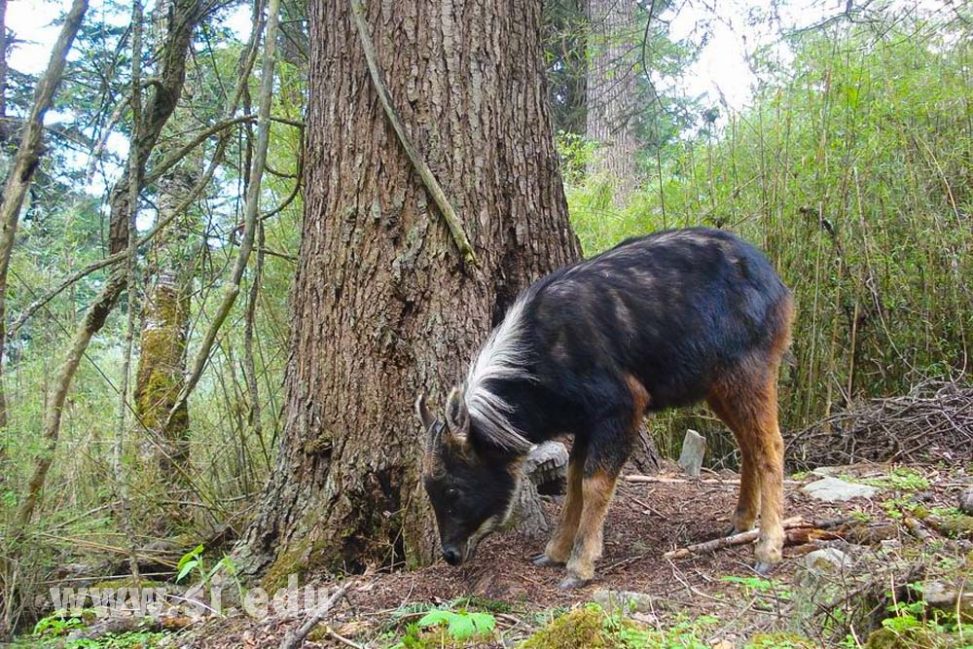A „typical“ Chinese Serow – with its long silvery mane – is an almost mystical animal that could rival with a unicorn. Of all serow species it covers the largest distribution area.
Names
Burmese: Tau tshiek
English: White-maned Serow, Chinese Serow, South-west Serow (3), Mainland Serow (5)
French: Serow de Chine (3), Saro de Chine (1)
German: China-Serau (3), Chinesischer Serau (5)
Russian: Китайский серау
Spanish: Sirao de China (3), Sirao chino (1), Serau chino (5)
Tibetan: Kha sya (1)
Taxonomy
Capricornis milneedwardsii David, 1869
Type locality: China
Previously classified as a subspecies of C. sumatraensis; monotypic (3). Other authors have devided the species into China Serow (C. milneedwardsi milneedwardsii) and Indochinese Serow (C. milneedwardsi maritimus). (1)
The taxonomic validity of this species, and its relationship to other species in the genus Capricornis needs to be assessed. (2)
Other (putative) scientific names and synonyms
Capricornis (Antilope) milne-edwardsi, David. Moupin, Sichuan, 1869 (4)
Nemorhedus edwardsii, David, 1871 (4)
Capricornis (milneedwardsi) argyrochaetes, Heude. Tshou-ki, Zhejiang, 1888 (1, 4)
In 1894 Heude collected the following 15 putative species/subspecies in Sichuan: (1, 4)
C. (m.) brachyrhinus
C. (m.) chrysochaetes
C. (m.) cornutus
C. (m.) erythropygius
C. (m.) fargesianus
C. (m.) longicornis
C. (m.) maxillaries
C. (m.) microdonticus
C. (m.) microdontus
C. (m.) nasutus
C. (m.) platyrhinus
C. (m.) pugnax
C. tchrysochaets
C. (m.) ungulosus
C. (m.) vidianus
C. m. collasinus, Heude. Kwantung, 1899
C. m. osborni, Andrews. Hui-yao, 20 mi. from Tengueh, Yunnan, 1921
C. m. montinus, M. Allen. Likiang Range, Snow Mountain, Yunnan, 1930
There is still an inconsistency concerning the spelling of the species name. Some authors write „milneedwardsi“ (1, 4) others „milneedwardsii“ (2, 5).
Similar species
The Chinese Serow is slightly larger than the Sumatran Serow. (5) The Sumatran Serow is overall black, the Red Serow red. Himalayan Serows feature the typical trichromatism – black, red, white. The Indochinese Serow is smaller and has a less striking mane.
Distribution
The Chinese Serow (Capricornis milneedwardsi milneedwardsii), virtually endemic to China (1) is widely distributed through much of central and south-eastern China. The general distribution range may be taken to include all the area of the Southwest China Region from southern Gansu southward through Sichuan and most of Yunnan, and beyond into Myanmar. (2)
The species is replaced in parts of northern Myanmar by the Red Serow (Capricornis rubidus), and probably by the Himalayan Thar (C. thar) in parts of western Myanmar. (2)
Populations in southeast China (south of the Yangtze river) are small and isolated, and their general distribution range falls within regions with relatively dense human populations which are well-exploited economic areas. Although no population estimates have been made in this area, numbers are believed to be decreasing and its distribution range is gradually being reduced. (2)
The distribution boundary between Chinese Serow (C. milneedwardsi) and Indochinese Serow (C. maritimus) is drawn by some authors close to the political boundary between China and Myanmar, Laos and Vietnam. It is uncertain, but likely, that the distribution ranges of C. milneedwardsii, C. maritimus and C. rubidus meet or overlap in Myanmar, Shan States (upper Salween River). However, Rabinowitz (1998) reported that the Red Serow and the Indochinese Serow distribution ranges do not overlap in Myanmar. (1)
General description
(strongly diverging figures!)
length / head-body: a large animal – 140-180 cm (1); 140-165 cm (3). (The Indochinese Serow is described as being smaller.)
shoulder height: 100 to 112 cm (1); 85-94 cm (3)
weight: 85-140 kg (1); 100-160 kg (3)
pelage: The body in the Chinese Serow is covered with coarse (1), long (3), lank (4), hairs and little underwool (1); generally black, grading to reddish on flanks, rump and tail (4, 3). Much white showing through from the white hair bases. (4)
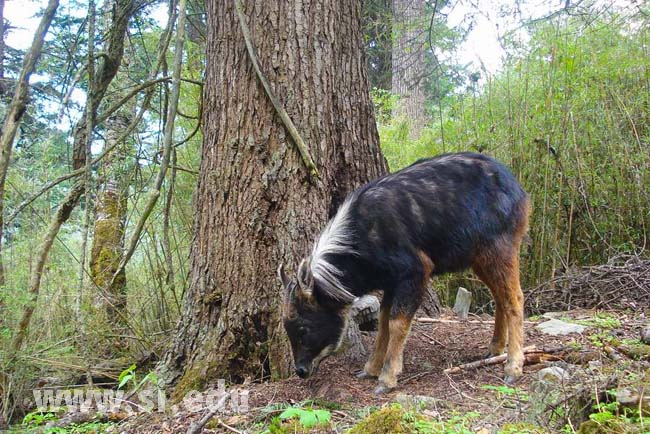
„Typical“ Chinese Serow: Because of animals like this the species was also called „White-maned Serow“. But not in all regions of the distribution range specimens show manes with this kind of long, silvery hair. It has been also suggested that mane characteristics are a function of age. Photo: Li Sheng, Wang Dajun and William McShee – Smithonian Wild
Differences in pelage colour can be attributed to area and age:
In the western parts of China the pelage colour is generally darker, superfically appearing deep black, although the bases of the hairs are grayish to whitish.
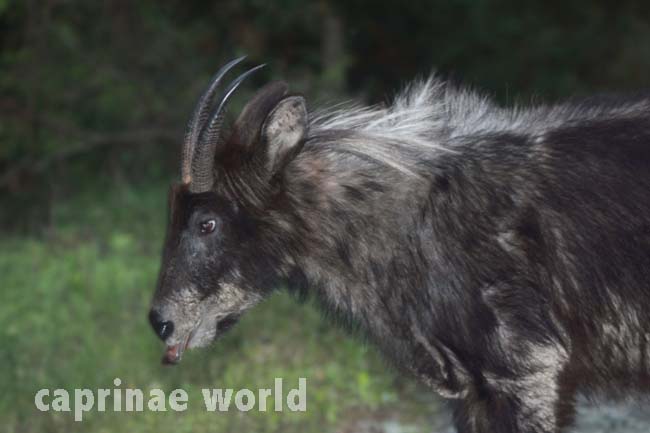
Chinese Serow from Tangijahe. In the western parts of China the pelage colour is supposed to be generally darker, although the bases of the hairs, being grayish to whitish, can shine through. Photo: Jon Hall – www.mammalwatching.com
In Zhejiang Province (Southeast China) serows appear to be blackish-brown and body hairs are more grizzled. (1)
Dolan (1963) blamed age for some of the differences between the described taxa. He noted that young animals can be black and adults, „strong brown“. (4)
underparts: in the Chinese Serow paler (3), light (4). (In the Indochinese Serow: darkish (1), often black (4))
dorsal stripe: In Chinese Serow (as well as in Indochinese Serow) a median stripe of allblack hairs extends down the back to the basal half of the tail. (1)
mane: In the Chinese Serow the typical mane is thick (1), long, shaggy, mainly silvery (3, 4) In animals from Zhejiang Province (Southeast China) hairs from the center mane are whithish with brown tips. (1) Dolan (1963) states that mane colour is also a function of age: older animals tending to have more white in the mane. (4) (In the Indochinese Serow the mane is short, sparse, with blackish and brownish hairs (1). But it can also be mixed with white or pale yellow-buff hairs. (4))
tail: 11-16 cm; bushy (3); 8-16 cm; black at the tip and russet in middle third, blackish mixed with gray basally (1). (In the Indochinese Serow it is apparently bushier.)
legs: from the „knee“ down Chinese Serow exhibit a rust colour which extends on the hind legs upwards along the edge of the buttocks. (1) Sometimes there is a sharp demarcation at the knee. (4) (In the Indochinese Serow the red of the legs seems – at least sometimes – not to be as obvious.)

Chinese Serow from Tangijahe: Probably more characteristic than the mane are the rusty legs – showing no white at the lower end. Photo: Jon Hall – www.mammalwatching.com
head / face: head large, sitting on a thick neck (1); browner than body (4, 3); Rabinowitz also confirms a brownish-black head colour for Myanmar (1), but there is not a single photos available showing a specimen with a brownish head.
Preorbital gland: prominent (3); forehead and face are black, sometimes slightly grizzled with whitish, and there is usually a tan spot on each side of the muzzle – lacking in animals from eastern areas. The lower lips are white (1) with a broad white jaw-streak, quickly becoming golden-brown backward, and ending before the gonion (4). The interramal (area between mandibles of the lower jaw) is black like the rest of the throat. (1) There can be a smudgy light patch on the upper throat. (4)
ears: 17-21cm (3); 18-21 cm, mule like, lined inside with long white hairs (1). (In the Indochinese Serow the insides of the ear are whitish to tawny. (1))
Horns
black; with straight, deep cancellations, diverging at first, but slightly converging at the tips. The mean values are – horn length: 21,1 cm; circumference: 13,3 cm and 10,5 cm. The longest recorded horn, which came from Yunnan, China, measured 26,7 cm; circumference: 14 cm; spread: 12,7 cm. (1) (Horns of the Indochinese Serow are said to be shorter. (1))
Habitat
The Chinese Serow inhabits rugged steep hills and rocky places, especially limestone regions up to 4,500 m asl (e.g. Duckworth et al. 1999; Lekagul and McNeely 1988, Smith and Xie 2008). However, the species is also routinely recorded (by camera-trapping) in hill and mountain forest areas with gentler terrain (R. Timmins pers. comm. 2008), and does occur in flatter areas marginally (Will Duckworth pers. comm. 2006). (2)
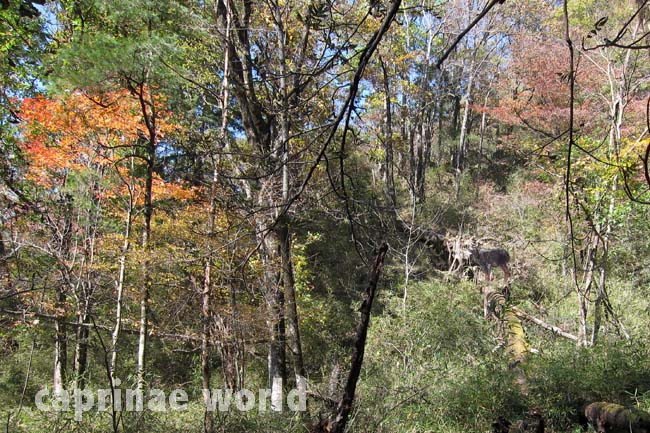
A Chinese Serow at Foping Nature Reserve at its resting place on a fallen tree. The serow was known to use the site repeatedly. Photo-collage
It is likely to tolerate moderately degraded habitat well, due to its presence in natural karst scrubland, though it is unlikely to be present in heavily disturbed areas such as agricultural land (W. Duckworth pers. comm. 2006), and has been documented amidst secondary forests and swidden in at least one landscape mosaics of such habitats and ‘primary’ forest (W. G. Robichaud in litt. to R. Timmins pers. comm. 2008). In parts of China it winters in the forest belt, ascending into alpine cliffs in summer (Yao, 1990). (2)
Mortality / Predators
In 1962, a die-off caused by an unknown epizootic was reported in the Tangjiahe area, Qingchuan County, Sichuan. (2)
Food and feeding
Primarily a browser (3); feeds on a wide range of leaves and shoots, and visits saltlicks. (2)
Breeding
gestation: no specific information available; but other serows give birth after a gestation period of 210 days (3)
young per birth: presumably a single young (3)
Activity patterns
probably principally diurnal; (3) mostly nocturnal and solitary. (2)
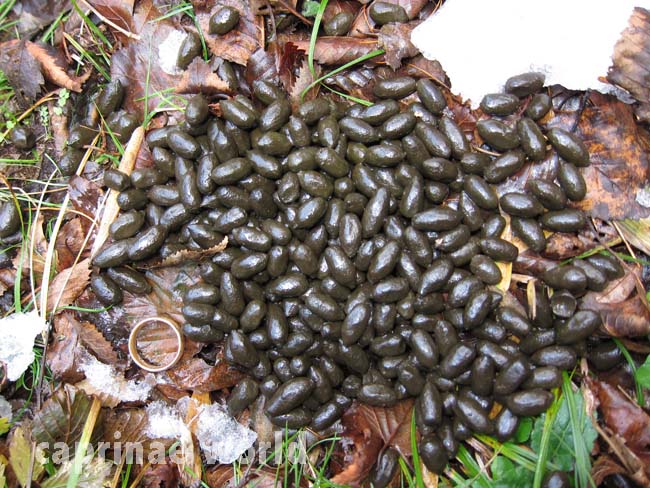
Dung of a Chinese Serow (identified by local guide – not confirmed, but plausible). Photo taken at Foping Nature Reserve, China. Diameter of ring: 2 cm
Movements, home range and social organisation
Older males are considered solitary, but detailed studies are lacking. (3)
Threats
The Chinese Serow is listed as „Near Threatened“ on the IUCN Red List. (2)
Populations of the White-maned Serow are not monitored. Therefore status and population numbers are unknown. It is considered to be decreasing in numbers but probably stable in some isolated areas. Greatest threats are habitat loss and degradations through deforestation and land clearing because of agricultural expansion, piecemeal clearance for firewood and timber resulting in fragmented populations. Illegal commercial hunting is also a factor. Meat, body parts used for medicinal purposes, and even live animals have a significant economic value for local people. (2, 3) The inaccessibility of much of the species preferred habitats is likely to be the serow’s main defence against eradication in most sites where it still occurs. (2)
Conservation Status / Action
In China it is in class II list of protected species.
This serow exists in many protected areas in the following provinces – Sichuan: Baihe, Fentongzhai, Jiuzhaiguo, Labahe, Mabian Dafengdin, Meigu Dafengdin, Tangjiahe, Tiebu, Wanglag, Wolong and Xiaozhaiziguo; in Shaanxi: Tabaishan, Foping (Wu et al., 1986) and Takin Reserve; in Gansu: Baishuijiang and Tou’ersantan; in Yunnan: Fenshuilin, Gaoligongshan, Tongbiguan, Xishuanbangnan and Yulonghabaxueshan (Lijiang and Zhongdian); in Fujian: Daiyunshan and Wuyishan; in Zhejiang: Fengyangshan and Jiulongshan; in Jiangxi: Jiulianshan and Wuyishan; in Guangxi: Congzuo Xiling, Huaping, Qianjiadong, Shouchen and Yindinshan; in Guizhou: Fenginshan; in Guangdung: Chebaling.
Conservation measures proposed for China: 1) Reclassify serow as Class I in the national wildlife protection list. 2) Ban hunting and 3) the State Commercial System should be prohibited from purchasing products of this animal. 4) Conduct basic population surveys to determine distributions and numbers for development of conservation actions. 5) Undertake studies of ecology, population and management problems of this serow as part of the conservation management program for the giant panda.
Trophy Hunting
not a factor
Ecotourism
negligible
Literature cited
(1) Damm, Gerhard R. and Franco, Nicolás, 2014: The CIC Caprinae Atlas of the World – CIC International Council for Game and Wildlife Conservation, Budakeszi, Hungary in cooperation with Rowland Ward Publications RSA (Pty) Ltd., Johannesburg, South Africa.
(2) Duckworth, J.W., Steinmetz, R. & Pattanavibool, A. 2008. Capricornis milneedwardsii. The IUCN Red List of Threatened Species 2008: e.T3814A10101852. http://dx.doi.org/10.2305/IUCN.UK.2008.RLTS.T3814A10101852.en. Downloaded on 20 May 2017.
(3) Wilson, D.E. and Mittermeier, R.A. [eds], 2011: Handbook of the Mammals of the World. Vol. 2. Hoofed Mammals. Lynx Edicions, Barcelona.
(4) Groves, Colin and Grubb, Peter, 2011: Ungulate Taxonomy. The John Hopkins University Press.
(5) Castelló, José R., 2016: Bovids of the World – Antelopes, Gazelles, Cattle, Goats, Sheep, and Relatives. Princton University Press.

